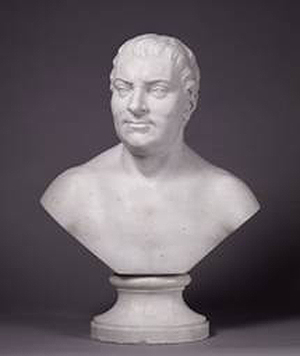
LONDON – The National Portrait Gallery has acquired the last portrait of the 18th-century British thinker Thomas Hollis – one of the architects of American independence – to remain in Britain.
The compelling marble bust, of circa 1760, by Joseph Wilton, RA (1722-1803), the greatest native-born sculptor in mid-18th-century Britain, is recognized as the finest likeness of the internationally renowned defender of civil liberty.
At his death Londoner Thomas Hollis (1720-1774) was known as a champion of liberty but, due to his retiring nature, his historical importance is only now being recognized. An advocate of the rights of the American Colonists, he was closely associated with Benjamin Franklin and John Adams. The growing mismanagement of the American Colonies through penal and coercive legislation saw Hollis lead the opposition to the Stamp Act of 1765, which sought to tax legal transactions of subjects who were denied representation in Parliament. This ultimately led to the American War of Independence.
Devoting his life to lobbying for parliamentary reform, opposing corruption and promoting democracy, the liberal thought engendered by his interaction with the Founding Fathers eventually influenced the writing of the American Constitution. He was a generous donor to Harvard University where Hollis, the Library’s electronic catalog system, continues to commemorate his patronage and influence on the founding tenets of American liberty.
Hollis represented American interests to the Prime Minister and tried to change British policy through both Parliament and the press. He influenced domestic and international politics by distributing works of radical political philosophy in England and America and this helped forge a framework for legitimate dissent. He also published the works of leading American radicals, to the extent that by 1770 Hollis had become, said historian Professor Caroline Robbins, “the busiest literary agent for American writers against the ‘usurpations’ of George III’s ministers.”
Wilton’s bust shows Hollis bare-chested in the character of the senator Brutus, and incorporates the emblems of Liberty cap and daggers to represent Hollis’s commitment to the principles of Roman democracy. With its naturalistic carving and unusual half-smile the bust has a surprisingly life-like quality which, in keeping with Wilton’s finest works and intimacy with the sitter, encourages the viewer to see the philosopher as a complex and dynamic character.
The celebration of the bust by other contemporaries was neatly encapsulated, more than 12 years after Hollis’s death, when John Adams, the future president of the United States of America, saw Wilton’s sculpture in 1786 and commented on “the bust of my friend … in beautiful white marble.”
Wilton was one of the foremost sculptors of his age and though he produced relatively few portrait busts his finest are unequalled – and this is one of his finest. Its powerful naturalism and starkness were groundbreaking and was at the forefront of the transition from the baroque to the neo-classical idiom in British portrait sculpture. The National Portrait Gallery owns busts by Wilton of William Pitt, First Earl of Chatham and General Wolfe.
“This bust captures Hollis’s personality and principles and conveys his uncompromising devotion to the principles of liberty. It will now be in the displays to help explore questions of 18th-century political protest and to tell the story of the foundations of both British democracy and British sculpture.” said Dr. Lucy Peltz, curator of 18th century portraits, National Portrait Gallery, London.
The gallery acquired the portrait following a loan period from a private collection, for £293,157 having received £100,000 towards its purchase from the National Heritage Memorial Fund (NHMF) and £57,000 from the Art Fund.
The purchase was made possible following a generous offer of the bust to the Gallery at less than its market value by the vendor Dr. David Wilson and a negotiated tax arrangement to the advantage of the vendor and the Gallery in a Private Treaty transaction approved by HM Revenue and Customs for a pre-eminent work of national heritage. That arrangement further reduced the purchase price paid by the Gallery to £293,157. David Wilson begins trading this week as a dealer in fine art (www.davidwilsonfineart.com).


